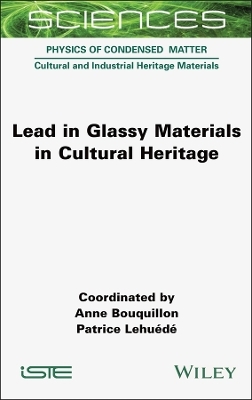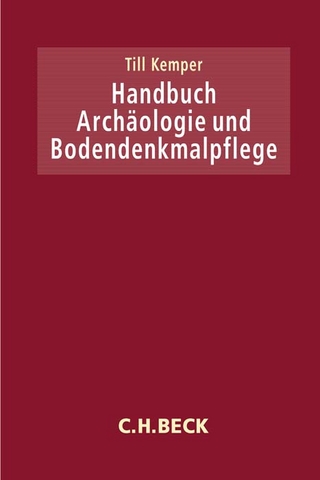
Lead in Glassy Materials in Cultural Heritage
Iste Ltd (Verlag)
978-1-78945-076-7 (ISBN)
Lead in Glassy Materials in Cultural Heritage traces the history of these skills and also looks at the most recent developments in materials science concerning the role played by lead in the properties of glass, including coloring. It develops an understanding of weathering processes and notions of the durability of leaded glass. It also examines public health issues and current recommended standards for the use of lead in industrial glass.
This multidisciplinary book is intended for a wide audience: art and technical historians, museum curators, restorers, materials specialists, manufacturers and engineers.
Anne Bouquillon is a research engineer in charge of studies on ceramics and plaster at C2RMF, France. She is editor-in-chief of the journal Techné. Patrice Lehuédé is former head of the Microanalysis Department at Saint-Gobain Recherche, France. He was a research associate at C2RMF from 2007 to 2020.
Foreword by Isabelle Pallot-Frossard xv
Foreword by Daniel R Neuville xvii
Introduction xix
Patrice LEHUÉDÉ and Anne BOUQUILLON
Part 1 Overview and Specific Techniques for the Analysis of Lead Glasses and Glaze 1
Chapter 1 Overview 3
Patrice LEHUÉDÉ
1.1 Advantages brought by lead 3
1.2 Difficulties related to the use of lead oxide 14
1.3 Conclusion 15
1.4 References 15
Chapter 2 Lead Isotopes for the Study of Ancient Glass 19
Alicia VAN HAM-MEERT and Patrick DEGRYSE
2.1 Lead isotope chemistry 19
2.2 The use of lead isotopes in archaeology 19
2.3 Lead isotopic analysis of glassy material 21
2.4 O, Sr, Nd and B isotopes for studying archaeological glass 28
2.5 Conclusion and future perspectives 30
2.6 Acknowledgments 31
2.7 References 31
Part 2 Structure of Lead Glasses: Influence on their Properties, Including Color 35
Chapter 3 Structure and Properties of Lead Silicate Glasses 37
Daniel CAURANT, Gilles WALLEZ, Odile MAJÉRUS, Gauthier ROISINE and Thibault CHARPENTIER
3.1 Introduction 37
3.2 Lead and lead oxides 40
3.3 Crystal phases and glasses of the SiO2-PbO system 46
3.4 Glasses of the SiO2-PbO-R2O system (R = Na, K) 72
3.5 Glasses of the SiO2-PbO-Al2O3 system 76
3.6 Conclusion 83
3.7 References 84
Chapter 4 Optical Properties and Coloration of Lead Silicate Glasses 93
Odile MAJÉRUS, Adèle MUNOZ-BONGRAND and Daniel CAURANT
4.1 Physical bases of optical properties and the origins of glass color 94
4.2 Optical properties and color of transparent SiO2-PbO-M2O glasses 99
4.3 SiO2-PbO-M2O glasses colored by transition ions 102
4.4 References 112
Part 3 History and Evolution of Lead Glasses 115
Chapter 5 Lead in the Recipes of the Middle Ages and Renaissance 117
Marco VERITÀ and Isabelle BIRON
5.1 The first written sources mentioning the use of lead 117
5.2 Recipes of translucent and opaque lead glasses from the Middle Ages and Renaissance 118
5.3 Conclusion 127
5.4 References 128
Chapter 6 The First Lead Glasses 133
Bernard GRATUZE
6.1 Introduction 133
6.2 Glasses of the Eastern Mediterranean from the second and first millennia BC 135
6.3 Lead glasses in Asia starting with the second half of the first millennium BC 139
6.4 Medieval lead glasses in Western Europe 141
6.5 European lead glasses, from the beginning of the modern period until the invention of crystal glass 145
6.6 Conclusion 148
6.7 References 149
Chapter 7 Lead in Glasses: Recent Times 155
Patrice LEHUÉDÉ
7.1 The adventure of lead crystal glass 155
7.2 New colorants of lead glass 157
7.3 The new opacifiers 160
7.4 The new processes of crystal glass decoration 161
7.5 New glassmaking techniques 164
7.6 Conclusion 167
7.7 References 168
Chapter 8 Early Islamic Lead Glass 173
Nadine SCHIBILLE
8.1 Introduction 173
8.2 Islamic lead silica glass (mina) from the Near East 175
8.3 Lead slag glass from Šaqunda (Córdoba) 184
8.4 Soda ash lead glass from al-Andalus 186
8.5 Concluding remarks 191
8.6 References 192
Chapter 9 Lead in the Enamels of the Middle Ages and Renaissance 199
Isabelle BIRON and Marco VERITÀ
9.1 Limoges champlevé enamels on copper from the Middle Ages 199
9.2 The so-called Venetian enameled coppers of the Italian Renaissance 204
9.3 References 211
Part 4 History, Implementation and Evolution of Lead Glazes 213
Chapter 10 History of Lead in Ancient Ceramic Materials 215
Anne BOUQUILLON
10.1 Introduction 215
10.2 Properties and implementation of lead glazes 216
10.3 The first lead glazes 218
10.4 Dissemination and evolution of the lead glazing technique in the high Antiquity 224
10.5 Hybridization of lead glazes with other ceramic traditions 229
10.6 The importance of lead-rich glassy materials in the race for porcelain 231
10.7 Innovations brought by Islamic potters of eighth to ninth century: the place of lead glassy materials 231
10.8 Soft-paste porcelains: lead glaze on translucent paste 239
10.9 Lead-rich vitrified paints 240
10.10 Conclusion 241
10.11 References 242
Chapter 11 Paste–Glaze Interaction 249
Laurent CORMIER and Marie GODET
11.1 Context 249
11.2 Paste–glaze interface 251
11.3 Factors affecting the paste–glaze interface 252
11.4 Cross-diffusion of chemical elements 256
11.5 Morphology of the interface 259
11.6 Identification of crystalline phases at the interface 260
11.7 Interface as an indicator of elaboration processes 267
11.8 Influence of interface on the physical properties 271
11.9 Conclusion 274
11.10 References 275
Chapter 12 Weathering of Ancient Lead Glazes 279
Anne BOUQUILLON
12.1 Slightly weathered glazes 280
12.2 Weak iridescences and pinholes 282
12.3 Advanced weathering in the context of burial 285
12.4 Protection of lead-glazed weathered objects by sol-gel methods 289
12.5 Conclusion 291
12.6 References 292
Part 5 Weathering of Lead Glasses and Standards 295
Chapter 13 Lead Leaching in Industrial Crystal Glasses: Role of Chemical Composition, Structure and Surface Treatments 297
Frédéric ANGELI, Léa BRUNSWIC, Thibault CHARPENTIER and Stéphane GIN
13.1 Influence of lead content on crystal glass structure 300
13.2 Leaching mechanisms of lead glasses 305
13.3 Industrial surface treatments limiting lead release by crystal glass 322
13.4 Conclusion 325
13.5 References 326
Chapter 14 Lead in Glass: Standards and Regulations 331
Denis LALART and Xavier CAPILLA
14.1 Lead uses in glassworks 331
14.2 Regulations related to lead 333
14.3 Food contact 336
14.4 Conclusion 338
14.5 References 339
List of Authors 341
Index 345
| Erscheinungsdatum | 01.02.2024 |
|---|---|
| Verlagsort | London |
| Sprache | englisch |
| Gewicht | 794 g |
| Themenwelt | Geisteswissenschaften ► Archäologie |
| ISBN-10 | 1-78945-076-4 / 1789450764 |
| ISBN-13 | 978-1-78945-076-7 / 9781789450767 |
| Zustand | Neuware |
| Informationen gemäß Produktsicherheitsverordnung (GPSR) | |
| Haben Sie eine Frage zum Produkt? |
aus dem Bereich


